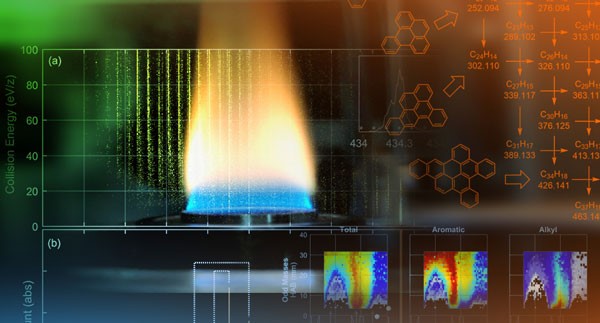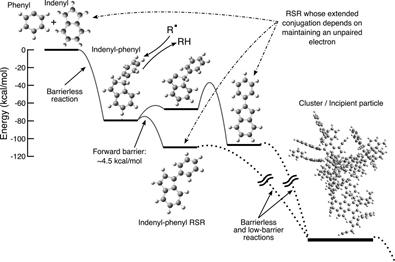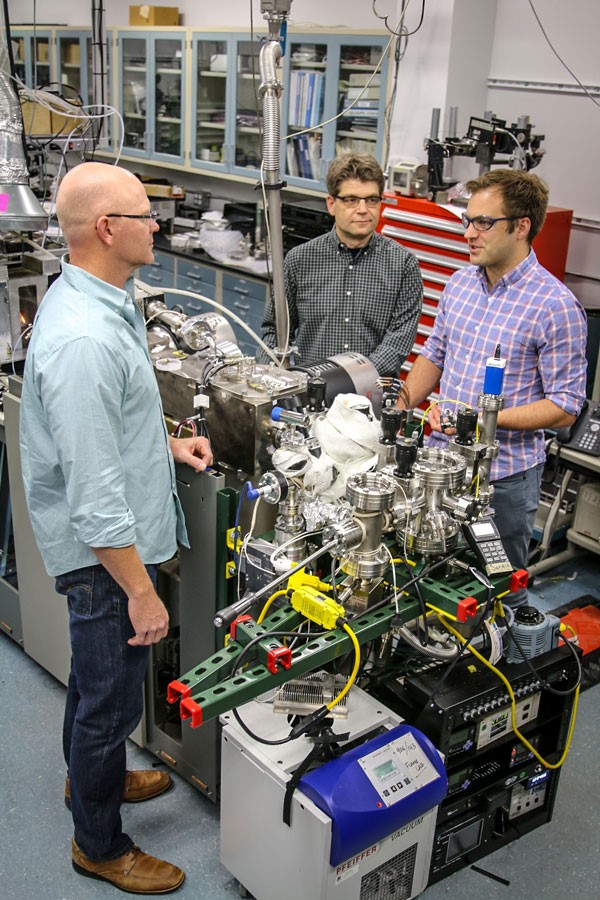The physical chemistry that enables particles to form and grow from gas phase precursors is highly complex and spans systems from the highly oxygenated particles of secondary organic aerosol to the carbonaceous particles of combustion, i.e., soot. At the CRF, scientists apply advanced mass spectrometric methods to probe the gas phase chemistry of polycyclic aromatic hydrocarbons (PAH) formation in the high-temperature environment of flames and to study the chain of reactions that lead to highly oxygenated molecules at atmospherically relevant temperatures.
Understanding soot inception requires a chemical mechanism that can covalently bond hydrocarbon precursors at high temperatures rapidly enough to explain particle formation. CRF researchers, in collaboration with Lawrence Berkeley National Laboratory and University of California–Berkeley, highlighted the possibility of clustering of hydrocarbons by radical-chain reactions (CHRCR) driven by resonance-stabilized hydrocarbon radicals. CRF scientists employed tandem mass spectrometry to identify aliphatically bridged polycyclic aromatic hydrocarbons and PAHs with aliphatic side chains, which have been hypothesized to serve as “seeds” for soot particles. Current work at the CRF links controlled experimental kinetics investigations, machine learning methods, and automated theoretical kinetics to understand the role of resonance stabilization in the clustering reactions that lead to soot.
The formation and growth of atmospheric aerosols, important for climate and Earth’s radiation balance, is linked to low-volatility, highly oxygenated molecules (HOM) from gas phase oxidation of hydrocarbons. CRF researchers have investigated the production of HOM via sequential reactions of Criegee intermediates from ozonolysis and multiple additions to molecular oxygen in peroxy-radical driven chemistry. These oxidation processes form a bridge between the high-temperature oxidation important in ignition and combustion and the lower-temperature conditions of tropospheric chemistry.



Key Contributions
- Observation of aliphatically-bridged aromatics in sooting flames
- Mechanism for rapid chain reactions of resonance-stabilized radicals
- Formation of highly oxygenated molecules from Criegee intermediate reactions in ozonolysis
- Demonstrated highly oxygenated intermediates in alkane autooxidation
- Showed separate evolution of surface and bulk of soot particles in a flame
Partners
- Hope Michelsen (University of Colorado)
- Kevin Wilson (Lawrence Berkeley National Laboratory)
- Ralf Kaiser (University of Hawaii)
- Yiguang Ju (Princeton University)
PIs: Nils Hansen, Habib Najm, Craig A. Taatjes, Judit Zádor